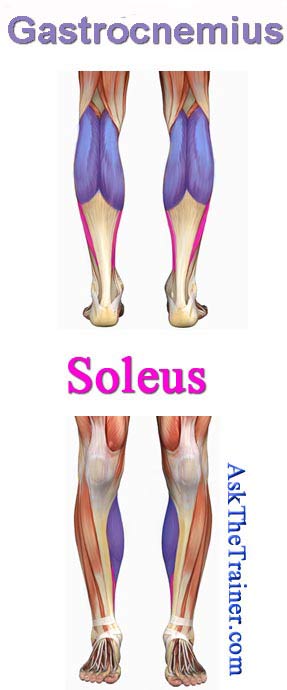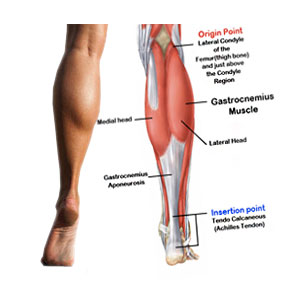- Like
- SHARE
- Digg
- Del
- Tumblr
- VKontakte
- Flattr
- Buffer
- Love This
- Save
- Odnoklassniki
- Meneame
- Blogger
- Amazon
- Yahoo Mail
- Gmail
- AOL
- Newsvine
- HackerNews
- Evernote
- MySpace
- Mail.ru
- Viadeo
- Line
- Comments
- Yummly
- SMS
- Viber
- Telegram
- JOIN
- Skype
- Facebook Messenger
- Kakao
- LiveJournal
- Yammer
- Edgar
- Fintel
- Mix
- Instapaper
- Copy Link
 Did you know that there are 9 muscles in the calf regions of each of your legs?
Did you know that there are 9 muscles in the calf regions of each of your legs?
The human body derives a vast amount of its power from the leg where strong, thick bones like the tibia and femur provide a sturdy foundation, and muscles, tendons, ligaments, and joints facilitate a wide range of movement.
Calf care plays an important role in both preventing injuries as well as performing your best. Don’t miss this quick guide to smart calf care and how to treat a pulled calf muscle:
Anatomy of the Calf
The backside of your lower leg between your knee joint and ankle is known as the calf and it is comprised of a handful of key muscles that give it its shape, strength, and flexibility.
The largest calf muscle is known as the gastrocnemius and it’s two “heads” come together to form the hallmark bulge under the skin that people commonly refer to as the calf muscle.
The other primary muscle in the back of the lower leg is the soleus; it lies under the gastrocnemius and is both smaller and flatter. As both muscles taper towards the base of the calf, the Achilles tendon connects them with the heel bone.
Causes and Symptoms of Pulled Calf Muscles
Like with any muscle strain, simply pulling any of your calf muscles past their maximum length can result in microtears in the fibers which make up the muscle. This can happen suddenly or over time with overexertion, repeated use, or impact.
Depending on the severity of the muscle strain, the diagnosis is categorized into “grades.”
Grade 1
A partial overstretching or tearing of one of the calf muscles may result in mild pain and tightness for one to two weeks, but should not affect strength or mobility.
Grade 2
When a larger percentage of muscle fibers are torn, moderate to severe pain, tenderness, and inflammation will occur. There may even be a popping or snapping sound at the instant the injury occurs. Leg weakness and discomfort may result in limping and inability to walk or run normally. There may also be bruising from bleeding under the skin where tissue cells were shredded.
Grade 3
The most severe case of calf strain is when there is a complete tear in one or more calf muscles accompanied by an audible “pop” at the time of injury. This results in both a visible deformity in the calf (may look like a dent) as well as extreme pain, tenderness, swelling, and bruising. Putting any weight on the affected leg will feel almost impossible, and blood may even flow down under the skin resulting in bruising around the ankle and foot.
You may experience a pulled calf muscle when you do things like introduce a ton of extra hill work into your walk or run or hyperextend the leg during sports play.
Common symptoms of mild to severe calf strain may also include:
- Frequent muscle spasms
- Weakness or tightness in the calf
- Sharp stabs of pain in the lower leg (especially when moving your knee or ankle)
- Throbbing pain in the lower leg even when you are sitting or lying down
Treating a Pulled Calf Muscle
Managing a pulled calf muscle takes time, patience, and commitment. It can be frustrating to miss out on your regular workouts because of a fitness injury like this one, however, it is critical that you take steps to prevent making the injury worse.
Following a physical exam and potential imaging scans with your doctor, a diagnosis as to which muscle is affected and the grade of strain will influence the recovery plan. Typically you will need to:
Rest
Giving your leg time to rest facilitates recovery by both preventing further injury as well as allowing the body time to repair itself without interruption. When possible, elevate your leg while resting to help alleviate swelling and reduce pain.
Apply Ice and Heat Packs
Ice therapy can most immediately address the swelling and tenderness associated with a muscle strain in the calf. Wrapping a cold pack around your leg while elevating it will numb spasming nerve endings, temporarily constrict blood flow, and reduce swelling. Alternating with warm heat packs will also soothe the affected muscles and reopen blood vessels to flush out built-up waste byproducts and deliver reparative nutrients and oxygen to the injured tissue.
Stretch and Strengthen
Depending on the degree of strain, you may need to work with a physical therapist to stretch and strengthen the muscle as you recover. Exercises that rebuild strength and flexibility may include heel lifts and some yoga poses. Compression wraps and calf braces can aid your fitness routine as you work towards recovery.
Medicate if Necessary
You may also utilize over-the-counter medicines like an anti-inflammatory to help with swelling and pain.
The Bottom Line
We rely on our legs for everyday mobility. Whether it’s walking to our car, standing from a chair, carrying our child, exercising, or walking up a flight of stairs, a healthy pair of legs is crucial. A weak or injured pair of legs is like a house on stilts with a termite infestation, and if it hasn’t already come crashing down, it’s only a matter of time. Because of this, calf care plays an important role in not only preventing and healing injuries but performing our best.

